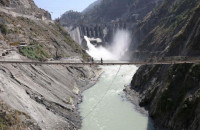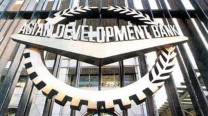Govt cuts proposed PSDP down to size
Rs250b reduction aimed at creating fiscal space for tax withdrawals

Hours before its approval by the National Assembly, the government has decided to cut the proposed Public Sector Development Programme (PSDP) of Rs1.4 trillion by Rs250 billion in a bid to create fiscal space for withdrawing some taxes without jeopardising the expected International Monetary Fund (IMF) deal.
Government sources told The Express Tribune that the finance ministry had conveyed its decision to slash the proposed development funds for the fiscal year 2024-25 by a record amount of Rs250 billion.
The reduction in the size of the PSDP even before its approval is over 17% of the sum approved by the National Economic Council two days before the budget.
On June 12, Federal Finance Minister Muhammad Aurangzeb proposed a record amount of Rs1.4 trillion for development spending during the upcoming fiscal year.
It has now been slashed to Rs1.15 trillion, confirmed the official sources.
The finance ministry’s response was awaited till the filing of this report.
Planning Minister Ahsan Iqbal was also not available for comments.
It is rare that the PSDP has been slashed after its presentation but before its approval by parliament.
The NA was scheduled to approve the Rs1.4 trillion PSDP on Wednesday.
The finance ministry has verbally communicated the reduction in the budget to the planning ministry.
However, the sources said the planning ministry was waiting for a formal intimation.
It was not decided till Monday evening whether the government would still seek the approval of Rs1.4 trillion from the NA because of the paucity of time in changing the budget documents or present revised new ceilings.
It will be the fifth change in the PSDP budget ceiling within a month by the finance ministry, indicating how badly the budget exercise is managed by the economic team this time.
Initially, the finance ministry had suggested an allocation of Rs1 trillion for the PSDP, only to later increase the figure to Rs1.221 trillion, which was duly approved by the Annual Plan Coordination Committee (APCC).
The third change came after a meeting at the Prime Minister’s Office and the PSDP was proposed to be jacked up to Rs1.5 trillion.
The fourth change came just before the meeting of the National Economic Council when the indicative number was reduced to Rs1.4 trillion because of the fact that the sum of Rs1.5 trillion would have required higher than Rs80 per litre petroleum levy to finance the PSDP.
The government has proposed in the budget that the petroleum levy should be increased from Rs60 to Rs80 per litre to collect a total Rs1.3 trillion under this head.
For the ongoing fiscal year, the NA had approved a Rs950 billion budget but the finance ministry placed over Rs200 billion cut in the fourth quarter to achieve the primary budget surplus target.
So far, a little over Rs550 billion has been spent out of the Rs950 billion original budget.
Slashing the PSDP after it is passed by the NA is quite common and carried out by every political government but it is unusual that a change is being made just before its approval.
There has been criticism against the finance ministry for slapping a record as well as highly inflationary amount of Rs1.5 trillion in new taxes and presenting the total budget coming to bloated sum of Rs18.9 trillion.
The proposed budget size of Rs18.9 trillion is 30% higher than the one in the ongoing fiscal year.
The sources said the government was facing immense pressure to reverse some of the tax proposals including the ones imposed on the salaried class, exporters, Khyber-Pakhtunkhwa’s tribal districts, milk, stationary, poultry and hybrid vehicles to name a few.
They added that to offset the impact of withdrawal of any of these measures, the government would have to make a cut on the expenditures.
However, even after placing a Rs250 billion cut on the PSDP, the budget still remains unrealistic as the proposed Rs13 trillion tax target is not fully backed by adequate measures, according to government sources.
They continued that in order to remain within the IMF’s prescribed spending limits, a cut had to be placed on the PSDP to make it more realistic.
The global lender will not announce a staff-level agreement with the country until it is satisfied that the new budget was realistic to a greater degree.
The sources said the IMF had also expressed concerns over the provincial budgets, which have impacted the primary budget surplus target of Rs1.217 trillion for the next fiscal year.
However, it will be a major challenge for the government to convince its allies about the need for reducing the provincial PSDPs, particularly protecting the development projects of Sindh.
To accommodate the PPP, a key partner in the ruling alliance, the coalition government not only increased the PSDP’s size to Rs1.4 trillion but also made a fiscally imprudent decision of again including all the provincial nature projects of Sindh in the national programme.
The sources said it would be challenging to readjust the ministries’ ceilings in light of the new developments.
Various ministries and organisations had requested for a Rs2.8 trillion development budget, which was subsequently reduced to Rs2.4 trillion.
The APCC had requested Rs1.5 trillion for the new and the ongoing schemes but the finance ministry came up with the final figure of Rs1.4 trillion.
There are 1,038 schemes that have been included in the next fiscal year’s PSDP and will require financing worth Rs9.8 trillion for their completion.



















COMMENTS
Comments are moderated and generally will be posted if they are on-topic and not abusive.
For more information, please see our Comments FAQ